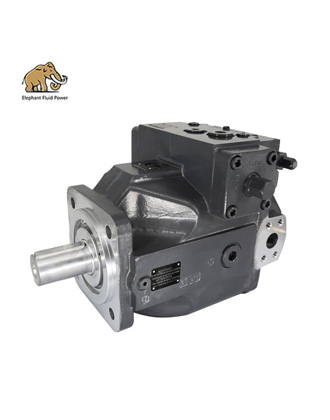In the world of engineering machinery, the hydraulic piston pump is a crucial component. It is akin to the "heart" of the equipment, providing power for various actions. To ensure the efficient operation of the equipment, it is vital to understand the usage and maintenance methods of hydraulic piston pump parts.
The impact of oil supply types on hydraulic piston pump parts
First, let's focus on the form of oil supply. Axial piston pumps are divided into two types: pressure oil supply and self-priming. For pressure oil supply hydraulic pumps, an air pressure oil tank is a common configuration, while some hydraulic pumps are equipped with a make-up pump to provide oil pressure at the inlet. Self-priming hydraulic pumps rely on their strong self-priming ability without the need for external oil supply.
During use, for hydraulic oil tanks that rely on air pressure to supply oil, the machine must be started and the hydraulic oil tank must reach the operating pressure before operating the machinery. Operating with insufficient air pressure may cause the sliding whip in the hydraulic pump to disengage, leading to abnormal wear of the return plate and pressure plate inside the pump. For piston pumps that use a make-up pump for oil supply, operators should check the pump 1-2 times daily to ensure the hydraulic pump's operating sound is normal. If the speed of the hydraulic cylinder decreases or the machine stalls, the make-up pump should be disassembled and inspected for scratches on the impeller edges or excessive internal gear pump clearance.
For self-priming piston pumps, the oil level in the hydraulic oil tank should not be lower than the minimum oil mark to maintain adequate hydraulic oil. Additionally, the cleanliness of the hydraulic oil directly affects the lifespan of hydraulic piston pump parts.
The importance of bearings in hydraulic piston pump parts
Next, let's focus on a key component of hydraulic pumps: bearings. The average lifespan of bearings is 10,000 hours. Once this value is exceeded, they need to be replaced. When disassembling bearings without professional testing equipment, visual inspection can be used. If scratches or discoloration are found on the roller surface, the bearing must be replaced promptly. When replacing bearings, note the English letters and model of the original bearing and try to purchase products from the original manufacturer and specifications. If replacing with other brands, consult experienced personnel for a compatibility chart to ensure the bearing's precision grade and load capacity.
Inspection and repair of friction pairs in hydraulic piston pump parts
The repair of the piston rod and cylinder hole, slipper and swashplate, and distribution plate and cylinder distribution surface requires professional techniques and methods. During the repair process, strictly follow the standards to ensure that the repaired hydraulic piston pump parts can restore their original performance and precision.
In summary, the use and maintenance of hydraulic piston pumps in engineering machinery are key to ensuring the equipment operates normally. Correct use and maintenance can extend the lifespan of hydraulic piston pump parts and improve equipment reliability and work efficiency. Additionally, during maintenance, it is important to choose professional repair personnel and high-quality parts to ensure repair quality and equipment safety. The maintenance and upkeep of hydraulic piston pump parts are not only related to the lifespan of individual components but also directly impact the operating state and efficiency of the entire equipment.
 French
French
 Portuguese
Portuguese
 Russian
Russian
 German
German
 Spanish
Spanish
 Japanese
Japanese
 Korean
Korean
 Irish
Irish
 Greek
Greek
 Turkish
Turkish
 Italian
Italian
 Danish
Danish
 Romanian
Romanian
 Indonesian
Indonesian
 Czech
Czech
 Afrikaans
Afrikaans
 Swedish
Swedish
 Polish
Polish
 Basque
Basque
 Catalan
Catalan
 Esperanto
Esperanto
 Hindi
Hindi
 Lao
Lao
 Albanian
Albanian
 Amharic
Amharic
 Armenian
Armenian
 Azerbaijani
Azerbaijani
 Belarusian
Belarusian
 Bengali
Bengali
 Bosnian
Bosnian
 Bulgarian
Bulgarian
 Cebuano
Cebuano
 Chichewa
Chichewa
 Corsican
Corsican
 Croatian
Croatian
 Dutch
Dutch
 Estonian
Estonian
 Filipino
Filipino
 Finnish
Finnish
 Frisian
Frisian
 Galician
Galician
 Georgian
Georgian
 Gujarati
Gujarati
 Haitian
Haitian
 Hausa
Hausa
 Hawaiian
Hawaiian
 Hebrew
Hebrew
 Hmong
Hmong
 Hungarian
Hungarian
 Icelandic
Icelandic
 Igbo
Igbo
 Javanese
Javanese
 Kannada
Kannada
 Kazakh
Kazakh
 Khmer
Khmer
 Kurdish
Kurdish
 Kyrgyz
Kyrgyz
 Latin
Latin
 Latvian
Latvian
 Lithuanian
Lithuanian
 Luxembourg
Luxembourg
 Macedoniar
Macedoniar
 Malagasy
Malagasy
 Malay
Malay
 Malayalam
Malayalam
 Maltese
Maltese
 Maori
Maori
 Marathi
Marathi
 Mongolian
Mongolian
 Burmese
Burmese
 Nepali
Nepali
 Norwegian
Norwegian
 Pashto
Pashto
 Persian
Persian
 Punjabi
Punjabi
 Serbian
Serbian
 Sesotho
Sesotho
 Sinhala
Sinhala
 Slovak
Slovak
 Slovenian
Slovenian
 Somali
Somali
 Samoan
Samoan
 Scots Gaelic
Scots Gaelic
 Shona
Shona
 Sindhi
Sindhi
 Sundanese
Sundanese
 Swahili
Swahili
 Tajik
Tajik
 Tamil
Tamil
 Telugu
Telugu
 Thai
Thai
 Ukrainian
Ukrainian
 Urdu
Urdu
 Uzbek
Uzbek
 Vietnamese
Vietnamese
 Welsh
Welsh
 Xhosa
Xhosa
 Yiddish
Yiddish
 Yoruba
Yoruba
 Zulu
Zulu







